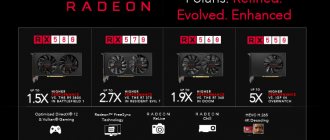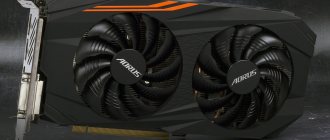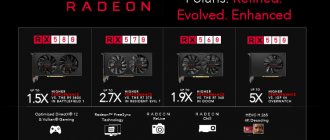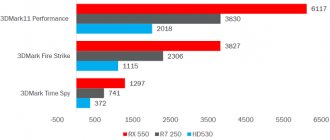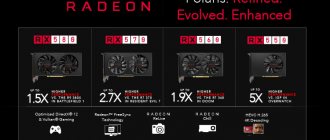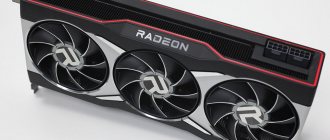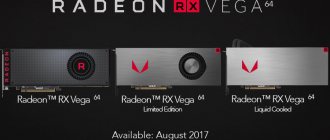Now all the attention in the discrete video card market is focused on the debut of the Radeon RX Vega family, which is especially successful in the price segment up to $500, which is occupied by the Vega 56, and NVIDIA’s response move - the upgrade of the GeForce GTX 1070 to the Ti version. Also, modifications of the Radeon RX Vega of the original design are just appearing on the market. But it's worth looking away from the passions in the upper echelon of GPUs to see how things are going among much more affordable 3D accelerators. Offers in the price category up to $100 are fully suitable for demanding AAA games (albeit with gentle graphics settings) - both in terms of GPU speed and RAM capacity, and at the same time, such chips are used in a lot of thin laptops with discrete graphics , and in finished computers they are found more often than their more expensive counterparts. Simply put, they are found almost everywhere.
In the GeForce 10 family, this niche is occupied by the GeForce GTX 1050 and GTX 1050 Ti. AMD products include the Radeon RX 460 in versions with 2 and 4 GB of RAM. Last year, when all these models were released, AMD had to make a compromise: while the RX 460 may not be as fast as its competitor's products, it is cheaper, which is important in this price category. In addition, the Polaris 11 GPU retained a part of the Compute Units (the main scalable resource in the GCN architecture), blocked in the Radeon RX 460. Since then, Polaris 11, together with the senior chip of the family, Polaris 10, has been updated with circuit design and process technology, which should increase the operating frequencies and energy efficiency of the GPU, and returned as part of the Radeon RX 560 with a fully active set of computing units. Let's see if AMD was able to tip the scales in its favor in this way.
AMD Polaris 21 GPU
Since the Polaris 21 chip is an optimized version of last year's Polaris 11 GPU, nothing has changed in terms of micro- and macro-architecture. However, a Polaris 21 die with a fully unlocked CU array, even without changes in clock speeds, automatically gains a 14% advantage in shader ALU and texture mapper throughput compared to both commercial Polaris 11 designs and Bonaire/Tobago chips, which AMD used the Radeon R7 260/360 series.
In addition, Polaris 21 incorporates all the advantages of the fourth generation GCN architecture, among which optimization of the memory stack occupies an important place: compared to Bonaire, the second level cache was increased here (from 512 KB to 1 MB) and color compression was introduced with a ratio of up to 8:1, allowing for more efficient use of memory bandwidth (the GPU back-end includes 16 ROPs and a 128-bit memory bus).
Among the other innovations introduced in GCN 1.4, we note the more efficient operation of the geometry engine, which is capable of cutting off polygons of zero size or those without pixels in the projection at the early stages of the pipeline. The work of Compute Units has also been tuned in order to increase their specific productivity. The GPU media block allows hardware encoding and decoding of video in HEVC Main 10 and VP9 formats with resolutions up to 4K. The display controller supports signal output via DisplayPort 1.3/1.4 and HDMI 2.0b interfaces, as well as HDR.
AMD Polaris 21 GPU Block Diagram
It is curious that, despite the relatively small computing power of Polaris 21, the developers endowed the chip with the same broad functions in the field of general-purpose calculations as the older GPU of the Polaris family. The front-end of the processor contains a total of seven schedulers: the Graphics Command Processor block for rendering commands, four ACEs (Asynchronous Compute Engine) for non-graphical calculations and two more blocks for computational commands, HWS (Hardware Schedulers), which have the ability to interrupt the execution chain of instructions for switching to a higher priority task.
Shader ALUs in Polaris support reduced-bit number formats - int16 and FP16, which are used in computational tasks that do not require more accurate representation (such as machine learning). As a result, the Radeon RX 560 is suitable for use cases such as debugging “calculation” code, which will then be executed on more powerful AMD solutions. Well, when a large number of GPUs acquire support for FP16 and are able to perform such calculations with sufficient speed, the format of floating-point numbers of reduced bit depth will be able to gain a foothold in game graphics - for operations that do not require more accurate representation.
You can get more detailed information about the Polaris chip architecture in our Radeon RX 480 review.
Technical characteristics, prices
The update of the GPU process technology and circuitry in the Radeon 500 series has significantly affected the performance-to-power ratio of the older models of the family. Thus, mass-produced samples of Radeon RX 570 and RX 580 in normal mode reach the same frequencies as the top modifications of their predecessors - RX 470 and RX 480 - with selected crystals and a developed cooling system. However, if in the case of older models AMD fully invested the freed-up energy efficiency resource in increasing frequencies, then the Radeon RX 560 specifications give AMD partners a choice. The reference TBP (Typical Board Power) is a range from 60 to 80 W, the lower limit of which lies within the standard power of PCI Express devices without an additional power connector (75 W). Due to this, manufacturers can easily produce compact single-slot video cards based on Polaris 21. On the other hand, shifting the TBP limit upward by 5 W, coupled with the increased energy efficiency of the second generation Polaris, allowed the peak GPU frequency to increase from 1200 to 1275 W. Thus, taking into account unlocked CUs, the theoretical performance of the RX 560 is 21% higher than that of the RX 460. The nominal effective RAM frequency is still 7000 MHz, and the volume is 4 GB.
| Manufacturer | AMD | |||
| Model | Radeon R7 360 | Radeon R7 260X | Radeon RX 460 | Radeon RX 560 |
| GPU | ||||
| Name | Tobago (Bonaire Pro) | Bonaire XTX | Polaris 11 | Polaris 21XT |
| Microarchitecture | GCN 1.1 | GCN 1.1 | GCN 1.3 | GCN 1.3 |
| Technical process, nm | 28 nm | 28 nm | 14 nm FinFET | 14 nm FinFET |
| Number of transistors, million | 2 080 | 2 080 | 3 000 | 3 000 |
| Clock frequency, MHz: Base Clock / Boost Clock | 1 050 /— | 1 100 /— | 1 090 / 1 200 | 1 175 / 1 275 |
| Number of shader ALUs | 768 | 896 | 896 | 1 024 |
| Number of texture mapping units | 48 | 56 | 56 | 64 |
| ROP number | 16 | 16 | 16 | 16 |
| RAM | ||||
| Bus width, bits | 128 | 128 | 128 | 128 |
| Chip type | GDDR5 SDRAM | GDDR5 SDRAM | GDDR5 SDRAM | GDDR5 SDRAM |
| Clock frequency, MHz (bandwidth per contact, Mbit/s) | 1 625 (6 500) | 1 625 (6 500) | 1 750 (7 000) | 1 750 (7 000) |
| Volume, MB | 2 048 | 2 048 | 2 048 / 4 096 | 2 048 / 4 096 |
| I/O bus | PCI Express 3.0 x16 | PCI Express 3.0 x16 | PCI Express 3.0 x8 | PCI Express 3.0 x8 |
| Performance | ||||
| Peak performance FP32, GFLOPS (based on maximum specified frequency) | 1613 | 1971 | 2150 | 2611 |
| Performance FP32/FP64 | 1/16 | 1/16 | 1/16 | 1/16 |
| RAM bandwidth, GB/s | 104 | 29/72 | 112 | 112 |
| Image output | ||||
| Image output interfaces | DL DVI-I, HDMI 1.4a, DisplayPort 1.2 | DL DVI-I, HDMI 1.4a, DisplayPort 1.2 | DL DVI-D, HDMI 2.0b, DisplayPort 1.3/1.4 | DL DVI, HDMI 2.0b, DisplayPort 1.3/1.4 |
| TBP, W | 100 | 115 | <75 | 60-80 |
| Retail price (USA, excluding tax), $ | 109 (recommended at the time of release) | 139 (recommended at the time of release) | 109/139 (recommended at the time of release) | 99 (4 GB recommended at time of release) |
| Retail price (Russia), rub. | From 7 260 / 7 700 (market.yandex.ru) | |||
In fact, various modifications of the Radeon RX 560 deviate significantly from AMD's TBP values - in both directions. The SAPPHIRE PULSE Radeon RX 560 4GD5 model, the example of which we will study the Radeon RX 560 today, is designed for 90 W of power at a maximum GPU frequency of 1300 MHz, and SAPPHIRE devices without additional power in the same series are rated at 45 W (and this is even less, than the Radeon RX 550!), albeit with the GPU frequency cut to 1212 MHz. In addition, almost every RX 560 model on the market comes in versions with 2 or 4 GB of RAM.
The recommended retail price of the Radeon RX 560 is set at $99, but in practice, even versions with 2 GB of RAM are not sold for less than $123 (according to the newegg.com catalog, excluding tax) or 7,260 rubles. (according to market.yandex.ru) In the case of the 4 GB RX 560, we are talking about prices of at least $129 and 7,700 rubles. However, the main competitor of the Radeon RX 560 with 4 GB RAM - the GeForce GTX 1050 Ti - costs even more (from $155 or 9,800 rubles), although the difference between the Radeon RX 560 2 GB and the GeForce GTX 1050 (from $119 or 7,670 rubles) is no longer so significant.
⇡#SAPPHIRE PULSE Radeon RX 560 4GD5: design
Like most Polaris 21-based graphics cards, the SAPPHIRE PULSE Radeon RX 560 is content with a very simple cooling system. The radiator installed on the GPU does not only have no heat pipes, but also no copper core. The only additional element is a separate block of fins on the transistors of the voltage converter. Therefore, the video card occupies two expansion slots in the case: in a single-slot design, it would be necessary to use copper or at least a prefabricated radiator made of thin fins soldered to the base. Nevertheless, the thermal conductivity of the aluminum billet is sufficient for a single fan with a diameter of 80 mm to stop rotating at low computing loads.
The video card has a standard set of video interfaces for solutions in the lower price category: one DisplayPort and one HDMI connector, as well as Dual-Link DVI-D.
⇡#SAPPHIRE PULSE Radeon RX 560 4GD5: board
The SAPPHIRE PULSE Radeon RX 560 board contains four 8-gigabit Micron 6TA47 D9SXD memory chips operating at their standard frequency of 1750 (7000) MHz.
The voltage converter includes only three phases for powering the GPU controlled by the ON Semiconductor NCP81022 PWM controller (this chip has been used in most AMD video cards since the Radeon R9 290X) and one phase for GDDR5 SDRAM chips. The additional power connector, in combination with the PCI Express slot's own power lines, provides a power reserve of 150 W, although standard BIOS settings allow for no more than 90 W.
Graphics cards with the best price/performance ratio:
Video cards. All test results
Gigabyte GeForce GTX 1080 Windforce OC 8GB GDDR5X
Overall rating: 75.7
Value for money: 100
Zotac GeForce GTX 1060 AMP! 6GB GDDR5
Overall rating: 55.7
Value for money: 90
Zotac GeForce GTX 1070 Ti AMP Extreme 8GB GDDR5
Overall rating: 73.2
Value for money: 89
Sapphire Radeon RX 580 Pulse 4GB GDDR5
Overall rating: 53.7
Value for money: 86
⇡#Test stand, testing methodology
| Test bench configuration | |
| CPU | Intel Core i7-5960X @ 4 GHz (100 MHz × 40), constant frequency |
| Motherboard | ASUS RAMPAGE V EXTREME |
| RAM | Corsair Vengeance LPX, 2133 MHz, 4 × 4 GB |
| ROM | Intel SSD 520 240 GB + Crucial M550 512 GB |
| power unit | Corsair AX1200i, 1200 W |
| CPU cooling system | Thermalright Archon |
| Frame | CoolerMaster Test Bench V1.0 |
| Monitor | NEC EA244UHD |
| operating system | Windows 10 Pro x64 |
| Software for AMD GPUs | |
| All video cards | AMD Radeon Software Crimson ReLive Edition 17.10.2 (Tesselation: Use application settings) |
| NVIDIA GPU software | |
| All video cards | GeForce Game Ready Driver 388.00 |
| Benchmarks: synthetic | |||
| Test | API | Permission | Full screen anti-aliasing |
| 3DMark Sky Diver | DirectX 11 (feature level 11_0) | 1920 × 1080 | Off |
| 3DMark Fire Strike | DirectX 11 (feature level 11_0) | 1920 × 1080 | |
| 3DMark Time Spy | DirectX 12 (feature level 11_0) | 2560 × 1440 | |
| Benchmarks: games | |||
| Game (in order of release date) | API | Settings | Full screen anti-aliasing |
| 1920 × 1080 | |||
| Crysis 3 + FRAPS | DirectX 11 | Max. quality. Start of the Swamp mission | Off |
| Metro: Last Light Redux, built-in benchmark | Max. quality | ||
| GTA V, built-in benchmark | Max. quality | ||
| The Witcher 3: Wild Hunt | Max. quality | ||
| DiRT Rally, built-in benchmark | Max. quality | ||
| Rise of the Tomb Raider, built-in benchmark | DirectX 12 | Max. quality, VXAO off | |
| Tom Clancy's The Division, built-in benchmark | Max. quality, HFTS off | ||
| DOOM | Vulkan | Max. quality. Foundry Mission | |
| Deus Ex: Mankind Divided, built-in benchmark | DirectX 12 | Max. quality | |
| Battlefield 1 + OCAT | Max. quality. Start of the Over the Top mission | ||
| Ashes of the Singularity: Escalation, built-in benchmark | Vulkan | Max. quality | |
| Total War: WARHAMMER II, built-in benchmark | DirectX 12 | Max. quality, Battle Benchmark | |
| Benchmarks: video decoding, computing | |
| Program | Settings |
| DXVA Checker, Decode Benchmark, H.264 | Files 1920 × 1080p (High Profile, L4.1), 3840 × 2160p (High Profile, L5.1). Microsoft H264 Video Decoder |
| DXVA Checker, Decode Benchmark, H.265 | Files 1920 × 1080p (Main Profile, L4.0), 3840 × 2160p (Main Profile, L5.0). Microsoft H265 Video Decoder |
| LuxMark 3.1 x64 | Hotel Lobby Scene (Complex Benchmark) |
| Sony Vegas Pro 13 | Sony benchmark for Vegas Pro 11, duration - 65 s, rendering in XDCAM EX, 1920 × 1080p 24 Hz |
| SiSoftware Sandra 2016 SP1, GPGPU Scientific Analysis | Open CL, FP32/FP64 |
| CompuBench CL Desktop Edition X64, Ocean Surface Simulation | — |
| CompuBench CL Desktop Edition X64, Particle Simulation - 64K | — |
Test participants
The following video cards took part in performance testing:
- AMD Radeon R9 370X (1000/5600 MHz, 4 GB);
- AMD Radeon RX 460 (1200/7000 MHz, 4 GB);
- AMD Radeon RX 560 (1275/7000 MHz, 4 GB);
- NVIDIA GeForce GTX 950 (1024/6610 MHz, 2 GB);
- NVIDIA GeForce GTX 960 (1127/7010 MHz, 2 GB);
- NVIDIA GeForce GTX 1050 (1354/7008 MHz, 2 GB);
- NVIDIA GeForce GTX 1050 Ti (1290/7000 MHz, 4 GB).
⇡#Performance: 3DMark
According to 3DMark, a test in which AMD GPU performance is usually much closer to the theoretical maximum than in real games, unlocking additional power in the Polaris 11/21 chip and increasing the clock speed allowed it to gain only 6% of points compared to the results of the Radeon RX 460. However, at least this is enough for the RX 560 to be not inferior to the GeForce GTX 1050 in terms of average score, while the GTX 1050 Ti retains its very significant advantage.
| 3DMark (Graphics Score) | ||||||||
| Permission | AMD Radeon RX 560 (1275/7000 MHz, 4 GB) | AMD Radeon RX 460 (1200/7000 MHz, 4 GB) | AMD Radeon R9 370X (1000/5600 MHz, 4 GB) | NVIDIA GeForce GTX 950 (1024/6610 MHz, 2 GB) | NVIDIA GeForce GTX 960 (1127/7010 MHz, 2 GB) | NVIDIA GeForce GTX 1050 (1354/7008 MHz, 2 GB) | NVIDIA GeForce GTX 1050 Ti (1290/7000 MHz, 4 GB) | |
| Sky Diver | 1920 × 1080 | 20 507 | 19 231 | 19 146 | 20 075 | 23 588 | 20 898 | 23 194 |
| Fire Strike | 1920 × 1080 | 6 461 | 6 122 | 6 102 | 6 229 | 7 314 | 6 664 | 7 388 |
| Time Spy | 2560 × 1440 | 1 960 | 1 821 | 1 582 | 1 817 | 2 220 | 1 778 | 2 257 |
| Max. | −5% | −6% | −2% | +15% | +3% | +15% | ||
| Avg. | −6% | −10% | −4% | +14% | −1% | +14% | ||
| Min. | −7% | −19% | −7% | +13% | −9% | +13% | ||
Performance: Gaming
In games at the current resolution for GPUs in this category, 1920 × 1080, the average difference between the Radeon RX 460 and RX 560 is just over 4%. Only in DOOM, a game based on the low-level Vulkan API, does the performance of the full-featured Polaris 11/21 chip come into full play. It is not surprising that the GeForce GTX 1050 Ti outperforms the AMD accelerator by 20%, and in some tests by as much as 50%. But look at video cards with 2 GB of RAM (and among models of previous generations, comparable to the Radeon RX 560 in terms of GPU performance, these are the majority) - in comparison with them, our test sample RX 560 sometimes achieves a double advantage due to 4 GB of memory.
| 1920 × 1080 | ||||||||
| Full screen anti-aliasing | AMD Radeon RX 560 (1275/7000 MHz, 4 GB) | AMD Radeon RX 460 (1200/7000 MHz, 4 GB) | AMD Radeon R9 370X (1000/5600 MHz, 4 GB) | NVIDIA GeForce GTX 950 (1024/6610 MHz, 2 GB) | NVIDIA GeForce GTX 960 (1127/7010 MHz, 2 GB) | NVIDIA GeForce GTX 1050 (1354/7008 MHz, 2 GB) | NVIDIA GeForce GTX 1050 Ti (1290/7000 MHz, 4 GB) | |
| Ashes of the Singularity: Escalation | Off | 17 | 16 | 15 | 18 | 26 | 16 | 19 |
| Battlefield 1 | 46 | 44 | 43 | 32 | 40 | 38 | 42 | |
| Crysis 3 | 34 | 34 | 34 | 35 | 41 | 39 | 42 | |
| Deus Ex: Mankind Divided | 23 | 22 | 19 | 8 | 8 | 8 | 26 | |
| DiRT Rally | 34 | 33 | 35 | 41 | 48 | 44 | 51 | |
| DOOM | 70 | 60 | 64 | 25 | 31 | 29 | 75 | |
| GTA V | 37 | 38 | 38 | 41 | 48 | 45 | 53 | |
| Metro: Last Light Redux | 42 | 41 | 44 | 47 | 56 | 54 | 56 | |
| Rise of the Tomb Raider | 33 | 33 | 30 | 19 | 24 | 20 | 35 | |
| Tom Clancy's The Division | TAA: Stabilization | 25 | 24 | 20 | 22 | 31 | 25 | 28 |
| Total War: WARHAMMER II | Off | 19 | 18 | 14 | 15 | 20 | 14 | 23 |
| The Witcher 3: Wild Hunt | 25 | 23 | 20 | 26 | 32 | 27 | 32 | |
| Max. | +1% | +5% | +21% | +53% | +29% | +50% | ||
| Avg. | −4% | −9% | −15% | +6% | −10% | +20% | ||
| Min. | −14% | −26% | −65% | −65% | −65% | −9% | ||
FPS in games
Assassin's Creed Valhalla
(2020) Better than NVIDIA GeForce GTX 680M, but worse than AMD Radeon R7 370.
| 1920×1080 / Ultra / 12.7 | 2560×1440 / Ultra / 11.0 | 3840×2160 / Ultra / 7.5 |
Valorant
(2020) Better than AMD Radeon R7 370, but worse than NVIDIA GeForce GTX 660.
| 1920×1080 / Ultra / 55.8 | 2560×1440 / Ultra / 45.6 | 3840×2160 / Ultra / 39.7 |
Death Stranding
(2020) Better than AMD Radeon R7 370, but worse than AMD Radeon R7 370.
| 1920×1080 / Ultra / 25.3 | 2560×1440 / Ultra / 19.6 | 3840×2160 / Ultra / 11.9 |
Cyberpunk 2077
(2020) Better than AMD Radeon R7 370, but worse than AMD Radeon R7 370.
| 1920×1080 / Ultra / 12.7 | 2560×1440 / Ultra / 11.9 | 3840×2160 / Ultra / 7.8 |
Apex Legends
(2019) Better than NVIDIA GeForce GTX 660, but worse than NVIDIA GeForce GTX 580.
| 1920×1080 / Ultra / 27.0 | 2560×1440 / Ultra / 20.1 | 3840×2160 / Ultra / 12.0 |
Metro Exodus
(2019) Better than AMD Radeon R7 370, but worse than NVIDIA GeForce GTX 660.
| 1920×1080 / Ultra / 15.3 | 2560×1440 / Ultra / 11.9 | 3840×2160 / Ultra / 7.5 |
Red Dead Redemption 2
(2019) Better than NVIDIA GeForce GTX 660, but worse than AMD Radeon R7 370.
| 1920×1080 / Ultra / 13.1 | 2560×1440 / Ultra / 10.7 | 3840×2160 / Ultra / 6.8 |
PlayerUnknown's Battlegrounds
(2017) Better than NVIDIA GeForce GTX 680M, but worse than NVIDIA GeForce GTX 1050 Ti Mobile.
| 1920×1080 / Ultra / 23.0 | 2560×1440 / Ultra / 17.5 | 3840×2160 / Ultra / 10.0 |
Overwatch
(2016) Better than AMD Radeon R9 280, but worse than NVIDIA GeForce GTX 770.
| 1920×1080 / Ultra / 45.5 | 2560×1440 / Ultra / 31.5 | 3840×2160 / Ultra / 16.1 |
Grand Theft Auto V
(2015) Better than NVIDIA GeForce GTX 1050, but worse than NVIDIA GeForce GTX 1050 Ti Mobile.
| 1920×1080 / Ultra / 27.2 | 2560×1440 / Ultra / 19.0 | 3840×2160 / Ultra / 9.0 |
The Witcher 3
(2015) Better than AMD Radeon Pro Vega 16, but worse than NVIDIA GeForce GTX 960.
| 1920×1080 / Ultra / 27.7 | 2560×1440 / Ultra / 20.4 |
Counter-Strike: Global Offensive
(2012) Better than AMD Radeon R7 370, but worse than NVIDIA GeForce GTX 660.
| 1920×1080 / Ultra / 81.4 | 2560×1440 / Ultra / 67.8 | 3840×2160 / Ultra / 61.0 |
League of Legends
(2019) Better than AMD Radeon R7 370, but worse than AMD Radeon R7 370.
| 1920×1080 / Ultra / 152.6 | 2560×1440 / Ultra / 84.8 | 3840×2160 / Ultra / 33.9 |
⇡#Performance: video decoding
Although the difference between Polaris 21 and Polaris 11 is not limited to additional CUs, and the new version of the chip is also redesigned in terms of circuit design, there was no room on the chip for a more powerful multimedia unit, which is equipped with Polaris 12 (Radeon RX 550). In terms of H.264 and H.265 decoding speed, the Radeon RX 560 is inferior to both modern competitors and NVIDIA GeForce 700/900 series video cards.
Still, the Radeon RX 560 is noticeably optimized for H.264 (compared to the Radeon RX 460) and has hardware support for H.265 at over 60Hz at 4K resolution, while up to Polaris are lower-tier AMD chips could decode H.265 only in software.
Note: since decoders within the same GPU line usually do not differ, the diagrams show one device from each family (or more if this rule is violated).
What is the RX 560 4gb suitable for in mining?
It is worth choosing Ethereum, since it is capable of delivering a hashrate of 13 MH/s. With a lucky coincidence, when you come across a durable video card that can withstand severe overclocking, this figure can increase to 15 MH/s. Let's look at the prices of the RX 560 4gb for mining in 2022:
The average cost is around $90, not counting sellers who set crazy price tags of 10,000 rubles. Next, let's take a look at the mining calculator to calculate how much the GPU can generate:
Mining per month will bring more than $26, and as a result, we get that the video card will fully pay for itself in 4 months, after which it will begin to generate net profit.
⇡#Performance: Computing
As for general-purpose computing, video cards of this level are not suitable for any serious tasks, but they can relieve the CPU in multimedia applications or be used for debugging OpenCL or CUDA program code. In this capacity, the Radeon RX 560 is on average inferior to the GeForce GTX 1050 Ti due to a weaker GPU, but still wins in applications that are successful for the AMD architecture and has wider support for various data formats compared to its competitor.
Drivers
Some people still believe in the myth about a bad driver for AMD video cards. This has not been the case for over ten years. Very high-quality software for AMD video cards is produced for Windows operating systems.
You can download the driver from the official AMD website. Its installation will not cause serious problems, because the process is no different from installing most other programs for Windows. The driver itself is automatically updated when new versions are released, the user does not need to do anything. If you have problems with automatic updating, you can update manually. This is done in two ways: through the driver settings menu or by downloading a new version of the package from the official website.
But we can only feel sorry for the users of operating systems based on the Linux kernel. The quality of drivers for this OS can only be described as “bottom”. Too big a difference compared to Windows software.
There are two drivers for the RX 560 under Linux: AMDGPU and AMDGPU-PRO. By default, all distributions use AMDGPU, a free driver developed by the community. Compatibility with games leaves much to be desired. The only good thing about this driver is that it updates automatically along with the operating system.
The official AMDGPU-PRO driver is supported only on a small number of distributions. Updating such a driver is more difficult than installing it. First you will need to remove it, which is also not easy under Linux, especially for beginners, and only then will you be able to install a new version.
⇡#Clock speeds, power consumption, temperature, overclocking
With 90W of power reserve, the SAPPHIRE PULSE Radeon RX 560 easily maintains the maximum GPU frequency both according to AMD specifications (1275 MHz) and with SAPPHIRE factory overclock (1300 MHz). Manually the graphics processor overclocks to 1425 MHz and consistently maintains this level in gaming tests. Any manipulations with voltage do not have a significant effect on overclocking: when raising from the standard 1.1 V to the maximum allowed by the BIOS settings (1.15 V), the frequency potential does not change, and reducing the voltage does not make much sense, since the GPU still does not “throttles” even during acceleration. We were able to add an additional gigahertz to the effective RAM frequency.
Despite the increased clock speeds of the second-gen Polaris, the RX 560 outperforms the RX 460 (also from SAPPHIRE) with 17 and 11 W in Crysis 3 and FurMark tests, respectively. The thing is that the old model has a higher GPU supply voltage - 1.187 V (at least that’s how our test sample RX 460 works). However, overclocking has virtually no effect on the RX 560's power consumption in games, and only in FurMark can a difference of 31 W be detected.
It is not surprising that at reference frequencies even such a simple cooling system, which the SAPPHIRE PULSE Radeon RX 560 is content with, is enough to keep the GPU temperature within 74 °C, and at maximum speed it was possible to reduce it by another 12 °C even during overclocking cores are 150 MHz higher than AMD specifications.
Comparison of parameters from different manufacturers
In the list of manufacturers of the Radeon RX 560 model you can find 7 different companies - from the more well-known Asus and MSI to HIS and Afox. However, even not the most popular brands produce video adapters with almost the same characteristics as Sapphire or Gigabyte products. The price level for video cards is also at the same level - two-gigabyte versions are included in the category up to 10,000 rubles, older models can be purchased for 10-13 thousand.
Table 1. Comparative characteristics of RX 560 video cards.
| Video card brand | CPU frequency, MHz | Memory frequency, MHz | Memory capacity, GB | Cost, thousand rubles. |
| HIS | 1149 | 6000 | 2 | 8,2 |
| Sapphire | 1226 | 4 | 11,8 | |
| 2 | 7,5 | |||
| Asus | 1275 | 7000 | 8,3 | |
| 1175 | 7,8 | |||
| 4 | 12,4 | |||
| 1285 | 12,6 | |||
| Afox | 1175 | 10,5 | ||
| MSI | 1196 | 12,3 | ||
| Gigabyte | 1199 | 12,1 | ||
| 1300 | 2 | 8,4 | ||
| PowerColor | 1176 | 8,0 |
Cooling systems for video cards of different brands may differ in the number of fans. For example, the ASUS RX560-4G model has two of them, but for a card from the MSI brand, one is enough. The difference can also be found in the design - some companies use only black for release, others make some parts of the video adapters red.
⇡#Performance: overclocking
Overclocking the Radeon RX 560 is quite productive in terms of converting additional megahertz of GPU frequency into frame rates. In 3DMark the gain was 8%, and in games the average difference in performance between an overclocked RX 560 and a card running at reference settings reached 10%. But in this case, a significant contribution to the result was also made by the increased frequency of RAM.
| 3DMark (Graphics Score) | |||
| Permission | AMD Radeon RX 560 (1275/7000 MHz, 4 GB) | AMD Radeon RX 560 (1425/8000 MHz, 4 GB) | |
| Sky Diver | 1920 × 1080 | 20 507 | 21 684 |
| Fire Strike | 1920 × 1080 | 6 461 | 7 006 |
| Time Spy | 2560 × 1440 | 1 960 | 2 128 |
| Max. | +9% | ||
| Avg. | +8% | ||
| Min. | +6% | ||
| 1920 × 1080 | |||
| Full screen anti-aliasing | AMD Radeon RX 560 (1275/7000 MHz, 4 GB) | AMD Radeon RX 560 (1425/8000 MHz, 4 GB) | |
| Ashes of the Singularity: Escalation | Off | 17 | 19 |
| Battlefield 1 | 46 | 51 | |
| Crysis 3 | 34 | 37 | |
| Deus Ex: Mankind Divided | 23 | 26 | |
| DiRT Rally | 34 | 37 | |
| DOOM | 70 | 81 | |
| GTA V | 37 | 41 | |
| Metro: Last Light Redux | 42 | 46 | |
| Rise of the Tomb Raider | 33 | 35 | |
| Tom Clancy's The Division | TAA: Stabilization | 25 | 26 |
| Total War: WARHAMMER II | Off | 19 | 20 |
| The Witcher 3: Wild Hunt | 25 | 28 | |
| Max. | +16% | ||
| Avg. | +10% | ||
| Min. | +4% | ||
Optimal processor for RX 560
Minimum level (sometimes performance will be limited by the processor) - 2 cores, 4 threads, suitable options:
- Intel Pentium G4560
- Intel Core i3 (any up to 7th generation)
Medium level (most optimal configuration) - 4 cores, 4 threads:
- Intel Core i5 (any up to 7th generation)
- Intel Core i3 8100
- AMD Ryzen 3 1200
High level (the processor will not be a weak point in the system) - more than 4 threads, for example:
- Intel Core i7 (any)
- Intel Core i5 8400, i5 8500
- AMD Ryzen 5 1500, Ryzen 7 1700
RX 560 with Pentium G4560 and i5 7500Comparison of RX 560 and GTX 1050 paired with Pentium G4560
⇡#Conclusions
Upgrading the Radeon RX 460 to the RX 560 with second-generation Polaris chips and unlocking additional CUs did not change the balance of power among budget gaming graphics cards. Even though on paper the RX 560 has 21% higher performance compared to the RX 460, in reality the difference does not exceed 5%, which means that nothing threatens the leading position of the GeForce GTX 1050 Ti, which, however, costs significantly more compared to Radeon RX 560 with 4 GB RAM. At the same time, the older version of the RX 560 looks favorably against the background of the GeForce GTX 1050, a model of comparable price, which is actually excluded from the list of gaming video cards by the limitation of 2 GB of onboard memory. As for the 2 GB versions of the Radeon RX 560, by and large, they may only be interesting for accelerating programs with OpenCL support or as part of an HTPC, although the latter task is performed even more successfully by the even cheaper Radeon RX 550.
At the same time, the replacement of Radeon RX 460 by RX 560 in the catalog of Polaris-based accelerators not only provided slightly higher performance, but also gave AMD partners carte blanche to release video cards with radically reduced power consumption (up to 45 W) for ultra-compact gaming PCs entry-level and the same HTPC.
Nvidia is better than AMD
To summarize, I will repeat the theme indicated in the title - Nvidia is better than AMD. Because it offers a more balanced and predictable solution at the moment. At least this applies to video cards of the Pascal and Polaris generation. In the case of Navi video cards, we are seeing significant positive changes, which I separately noted above. Therefore, I obviously have no right to speak badly about them. AMD has definitely done some work on the bugs, and the Navi family video cards are pleasing with their performance. However, they are still unable to saturate the market. Nvidia offers a full range of products to suit every taste and pocket. At a time when AMD offers only two lines of video cards, and here I return to where I started this post. Why do we need such video cards at all? Moreover, there is at least some logic in Nvidia’s actions; they adjust the line to suit needs and wallets; the appearance of Super series video cards, coupled with lower prices, clearly demonstrates this. At the same time, the market for used video cards is successfully saturated with all the same video cards at even more affordable prices. The GTX 1660 can already be found cheaper than the same RX 5500 XT and GTX 1660 Super in stores, and these will be fresh video cards, because they came out not so long ago. What is AMD doing? Releases the RX 5500 XT with the performance of the RX 590 at the price of the RX 590, despite the fact that the secondary market is already oversaturated with Polaris series video cards with price tags half or even three times lower. You know what, I’ll say it very briefly and very simply - the GTX 1070 for 10,000 rubles from the secondary market completely covers absolutely the entire retail segment of video cards, up to the RTX 2060 and RX 5700. And on this note, I’ll probably end it. And I invite you to share your opinion in the comments what you think about all this.
The issue of cooling also remains open. Share your experience and opinion in the comments. What could happen that the video card no longer adequately maintains operating temperature in normal mode? I don’t believe in “thermal paste drying out”. More precisely, I do not believe in such an effect from drying out thermal paste, at least in the absence of mechanical impact on the radiator, as a result of which the contact could somehow be disrupted. In this case, this is almost completely excluded, because The radiator is attached to the video card with at least four cross screws, which should completely eliminate the factor of mechanical movement of the radiator. This means that even if the thermal paste has “dried up”, its consistency and contact patch should not be disturbed.
